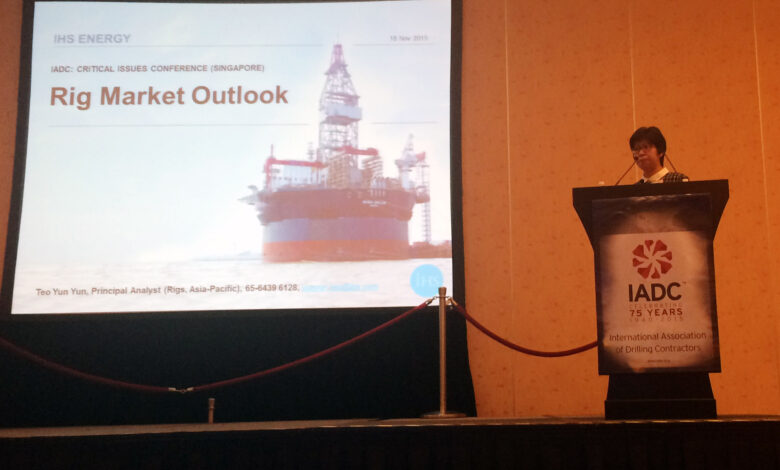IHS: Perfect storm puts pressure on contractors on both supply and demand

By Linda Hsieh, Managing Editor
Drilling contractors are in the midst of a perfect storm right now, Yun Yun Teo, IHS Principal Analyst for Rigs, Asia Pacific, said. “On one hand you have an oversupply of rigs, both old and new. On the other hand, operators’ demand has been very sluggish, and they’ve been cutting back since early 2014,” she said at the 2015 IADC Critical Issues Asia Pacific Conference on 18 November in Singapore.
Of the 310 delivered floaters worldwide, just over half – 174 – are currently drilling, she shared in her presentation. On the jackup side, 337 of the 541 units worldwide – 62% – are drilling. “Operators are asking for discounts, so we’re seeing blend-and-extend contracts and renegotiation at reduced rates between 20-30% lower,” Ms Teo said. She cited the example of a rig in Thailand whose contract was recently extended by nine months but the dayrate came down from $165,000 to $85,000. “If you don’t play ball, there’s a high chance you will get terminated,” she added.
More recently, IHS has also seen newbuild contract cancellations. Ms Teo highlighted one example of a newbuild drillship that was on its way from the South Korean shipyard to the Gulf of Mexico when the operator decided to terminate the contract. Under contract terms, she said, the operator has to pay the contractor two years of dayrate at $550,000, which works out to approximately $400 million. “Unfortunately, not all rig contracts are so strong.”
Contractors themselves have also been deferring newbuild deliveries. “I’ve come to the realization some time back that all the rigs are going to get built, but the deliveries are going to get pushed out until the market has recovered,” she said. IHS data shows that there are 125 jackups in construction yards, only 10 of which have contracts secured already. Of these 125, delays have been announced for 17 units. “Aside from them, we know of at least 20 units where the rigs have been substantially completed. However, the owner has not taken delivery of them.”
Ms Teo highlighted the fact that China has captured a big share of the jackup construction market, with 72 of the 125 rigs being built in Chinese yards. These yards tend to offer very generous financing. “They only have to pay 5% down payment and 95% upon delivery. Because of that we have attracted a lot of speculative investors, and it’s easy for them to walk away and default,” she said. However, the yards have much more incentive to find another taker and are keeping the jackups dockside.
For floaters, IHS’ count shows there are 70 units being built around the world. “It’s about 50/50 contracted and uncontracted. However, for the 25 units that we know have contracts, almost half of them – 14 – were for Petrobras and will likely be canceled,” she noted.
On the flip side of the rig market – attrition – not nearly enough rigs have been taken out of the market to shift the market to a rebalance. “For floaters, we have had record attrition over the last two years – 42 – and 27 alone this year. But you can see nowhere is the attrition numbers matching the number of newbuilds coming on.” Ms Teo said the total floater supply has grown from approximately 200 in 2008 to just over 300 now. That number is likely to balloon to just under 400 by 2020.
“The scenario is even worse for jackups,” she continued. “Jackup contractors are continuing to show a preference to stack. To be fair, in 2012 when things were bad, there was record attrition, but in the last two years we’ve only had 14 departures of jackups. Instead, what most jackup owners have been doing is to stack the rig when it comes off contract.” There are currently 156 jackups in various modes of stacking, she added.
Looking to the future, Ms Teo said that although this remains a highly competitive and oversupplied market, there are always countercyclical opportunities in a downturn. There hasn’t been many M&A’s yet, though there will likely be more in the future. “For rig acquisition, it’s probably early days yet. I’m told prices have not fallen low enough for that to take place.”




